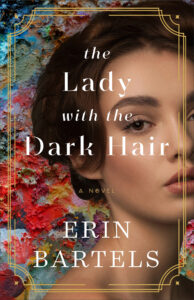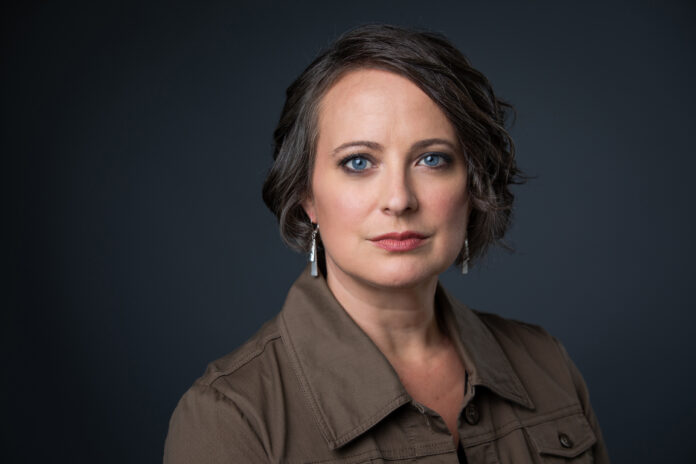Welcome to the blog Erin. Today, we’re excited to be talking about your latest release The Lady with the Dark Hair. First, tell our readers a little bit about the book.
Esther Markstrom and her artist mother have always been proud of their ancestor, painter Francisco Vella. They even run a small museum and gallery dedicated to raising awareness of his scandalously underappreciated work. But when Esther reconnects with her former art history professor, she finds her once-solid family history on shaky ground as questions arise about Vella’s greatest work—a portrait entitled The Lady with the Dark Hair.
In 1879, Catalan orphan-turned-fugitive Viviana Torrens has found sanctuary serving in the home of an aging artist in Southern France. It is in his studio that she meets Francisco Vella, a Gibraltarian merchant who sells artists’ pigments. When her past catches up to her, she is compelled to pose as Vella’s sister and join him on his travels or be deported back to Spain to stand trial. Along the way she will discover that the many parts she has been playing in order to hide her identity have far-reaching implications she never could have foreseen.
What was the inspiration for your novel?
I don’t remember a time when I did not draw and paint. From an early age, when I had free time I was doing one of four things: reading, climbing trees, pretending to be a tiger, or making art. Painting has been a way to escape, a way to explore, and, in recent years, a way for me to do something that doesn’t involve looking at a screen.
I became very interested in women painters specifically after reading The Mirror and the Palette by Jennifer Higgie. I think it was around that time that I started work on The Lady with the Dark Hair—and I started trying my hand at self-portraiture. Over the course of 2022, I painted one self-portrait each month in an attempt to get better at painting people. At the same time, I was writing this book about women artists, identity, and what we see when we really take the time to look at ourselves for who we are.
The Lady with the Dark Hair is a dual-time story. What are the different locations and time periods covered in your book?
The past storyline begins in 1879 in Toulouse, France, and takes readers to early 1880s Gibraltar, by way of Paris at the very beginning of La Belle Époque. The present-day story begins in East Lansing, Michigan, and takes readers to modern-day Gibraltar.
Can you please tell readers about your two protagonists, Esther Markstrom and Viviana Torrens? How are the two connected?
Esther is a former art history major who has been running her family’s small museum in the American Midwest and taking care of her eccentric artist mother for twenty years. Her life is restricted to about a five-mile radius around her home, the walls of which are covered in decades’ worth of her mother’s self-portraits. She presses on, fulfilling her duties to take care of her mother and the family legacy of being Francisco Vella’s descendants. But she yearns to slough off these responsibilities to live a bigger life, one filled with travel, adventure, and, if she’s lucky, a bit of romance.
After posing as a boy to serve alongside her brother in the Catalan army’s war with Spain in the 1870s, Viviana is now working as a scullery maid in an artist’s home in Southern France. There she meets a Gibraltarian merchant, Francisco Vella, who sells paints and pigments to artists. She becomes a model for her artist employer, then his student, but is compelled to leave in the guise of Vella’s sister when news of her crimes during the war reaches France. As she follows Vella on his trade route, she gets to see the world, but everywhere she goes she is underestimated, restricted, and condescended to, because of both her sex and her assumed identity.
Though they live in vastly different worlds, both women feel caged by societal expectations and their own self-doubt. And in some sense, both have Francisco Vella to blame.
Esther’s once-solid family history is on shaky ground when questions arise about her ancestor, painter Francisco Vella. Can you please provide some clue to the mystery surrounding her family?
Esther’s most prized possession, among all the other paintings her family owns and displays in their museum, is a portrait entitled The Lady with the Dark Hair. It hangs over the fireplace in the home she shares with her mother, an artist in her own right who suffers from schizophrenia. Their family has always believed it was painted by their ancestor, Francisco Vella. But when Esther reconnects with a college art history professor and shows him the painting, he questions the long-held view and starts her on a quest to defend her position and prove its provenance.
Viviana is determined to hide her identity. But doing so results in far-reaching implications. Can you provide some insight into what these implications are?
With Viviana’s character I wanted to explore the ways in which women change themselves in order to fit others’ expectations. In her case, this tendency is extreme because she truly is using assumed names and identities to avoid legal repercussions. But as she pretends to be these other people, she loses more and more of her essential self until Viviana Torrens is altogether forgotten by history, even though she leaves behind an enormous amount of evidence of her existence.
What are some of the main themes covered in The Lady with the Dark Hair?
From the very start, this book is about women—women artists, women business owners, women caretakers, women who serve—women who are limited by circumstance, societal expectations, and their own inner critic, who doubt their contribution to the world, their worth, and their talent. It’s about confronting all the restrictions placed on women, both external and internal, and stepping out into a life of creativity, personal fulfillment, and rich relationships built on mutual respect and acknowledgment of one’s essential personhood. It’s also about owning your success, being proud of your accomplishments, and making your mark on the world.
What do you hope readers will gain from reading your book?
I hope readers will come away with an appreciation for and a desire to learn more about women’s contributions over the centuries to the arts specifically and to culture in general. I hope women readers in particular will turn that appreciation back on themselves and acknowledge their own gifts, callings, and talents. I hope that at least some come away energized to prioritize their own creative pursuits even as they are raising families, taking care of aging parents, and working at jobs that pay the bills. Because art is for everyone.
Where can readers purchase a copy of The Lady with the Dark Hair?
The Lady with the Dark Hair is available wherever books are sold. I always encourage people to support their local independent bookstore by ordering from them.
How can readers connect with you?
You can find me online at www.ErinBartels.com, on Facebook @ErinBartelsAuthor, and on Instagram @ErinBartelsWrites.
Thank you so much for stopping by the blog today, Erin.
Reader’s here’s a quick look at The Lady With the Dark Hair:
 Esther Markstrom and her artist mother have always been proud of their ancestor, painter Francisco Vella. They even run a small museum and gallery dedicated to raising awareness of his scandalously underappreciated work. But when Esther reconnects with her former art history professor, she finds her once-solid family history on shaky ground as questions arise about Vella’s greatest work–a portrait entitled The Lady with the Dark Hair.
Esther Markstrom and her artist mother have always been proud of their ancestor, painter Francisco Vella. They even run a small museum and gallery dedicated to raising awareness of his scandalously underappreciated work. But when Esther reconnects with her former art history professor, she finds her once-solid family history on shaky ground as questions arise about Vella’s greatest work–a portrait entitled The Lady with the Dark Hair.
In 1879, Catalan orphan-turned-fugitive Viviana Torrens has found sanctuary serving in the home of an aging artist in Southern France. It is in his studio that she meets Francisco Vella, a Gibraltarian merchant who sells artists’ pigments. When her past catches up to her, she is compelled to pose as Vella’s sister and join him on his travels or be deported back to Spain to stand trial. Along the way she will discover that the many parts she has been playing in order to hide her identity have far-reaching implications she never could have foreseen.
This dual-timeline story from award-winning author Erin Bartels takes readers from the sleepy Midwest to the sultry Mediterranean on a relentless search for truth, identity, and the freedom to follow one’s dreams.






